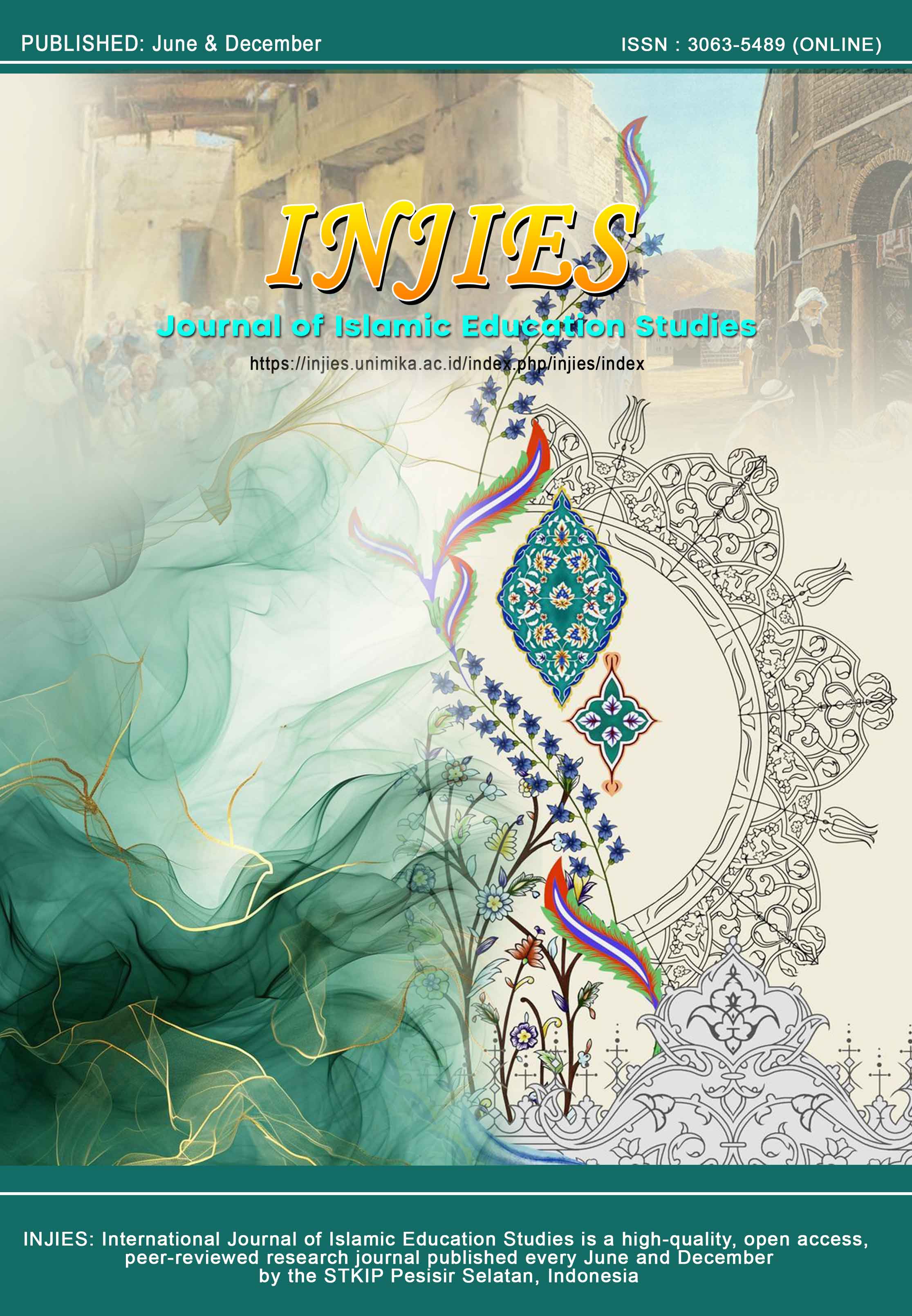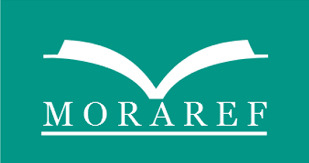The Correlation Between Islamic Learning Environment and Children's Multiple Intelligence Development
DOI:
https://doi.org/10.34125/injies.v2i1.17Keywords:
Islamic Learning Environment, Multiple Intelligences, Islamic Education, Islamic CharacterAbstract
Islamic-based learning environments play a crucial role in developing children's multiple intelligences by integrating Islamic values in physical, social, and spiritual aspects. This study examines the correlation between Islamic learning environments and the development of children's multiple intelligences based on Howard Gardner's theory of multiple intelligences. Using a qualitative approach with a literature review method, this study analyzed various academic sources that discuss Islamic educational environments and their influence on children's cognitive, social, and emotional aspects. The results of the study indicate that Islamic learning environments that emphasize the principles of tauhid, tarbiyah, adab, ta'lim, and fitrah are able to create a conducive atmosphere to optimize various intelligences, including linguistic, logical-mathematical, visual-spatial, musical, kinesthetic, interpersonal, intrapersonal, and naturalistic. Educational approaches such as memorizing the Qur'an, discussion-based learning, and integrating science and Islam have proven effective in increasing children's intelligence potential. In addition, the application of adab in social interactions and the formation of Islamic character contribute to increasing interpersonal and intrapersonal intelligence.In the era of globalization and digitalization, the challenge of maintaining a balance between tradition and modernity is important. Therefore, this study highlights the urgency of utilizing technology that remains in line with Islamic values to enrich the learning experience. The implications of this study provide insight for educators, parents, and policy makers in designing a holistic educational environment, not only academically oriented, but also forming Islamic character and improving children's intelligence as a whole.
Downloads
References
Abdullah, Moh., Abu Bakar, Y., & Rachman Assegaf, Abd. (2024). The Relevance Between Pesantren’s Character Education and Ismail Raji Faruqi’s Thought. Santri: Journal of Pesantren and Fiqh Sosial, 5(1), 39–54. https://doi.org/10.35878/santri.v5i1.1008
Ahmad Fauzan, & Muhammad Asrori. (2025). Examining the Urgency of Adab-Based Learning. Peradaban Journal of Religion and Society, 4(1), 47–59. https://doi.org/10.59001/pjrs.v4i1.282
Amram, Y. J. (2022). The Intelligence of Spiritual Intelligence: Making the Case. Religions, 13(12), 1140. https://doi.org/10.3390/rel13121140
Anderson, N. J., Graham, S. A., Prime, H., Jenkins, J. M., & Madigan, S. (2021). Linking Quality and Quantity of Parental Linguistic Input to Child Language Skills: A Meta‐Analysis. Child Development, 92(2), 484–501. https://doi.org/10.1111/cdev.13508
Arnidha, Y., & Maulani, E. (2022). The Effect of Intrapersonal and Interpersonal Intelligence on Mathematics Learning Motivation. UNION: Jurnal Ilmiah Pendidikan Matematika, 10(2), 217–225. https://doi.org/10.30738/union.v10i2.12234
Cantor, P., Lerner, R. M., Pittman, K. J., Chase, P. A., & Gomperts, N. (2021). Whole-Child Development, Learning, and Thriving. Cambridge University Press. https://doi.org/10.1017/9781108954600
Chanifah, N., Hanafi, Y., Mahfud, C., & Samsudin, A. (2021). Designing a spirituality-based Islamic education framework for young muslim generations: a case study from two Indonesian universities. Higher Education Pedagogies, 6(1), 195–211. https://doi.org/10.1080/23752696.2021.1960879
Fadillah, N. H., Kusuma, A. R., & Rajab al-Lakhm, N. R. (2023). The Concept of Science in Islamic Tradition: Analytical Studies of Syed Naquib Al-Attas on Knowledge. Tasfiyah: Jurnal Pemikiran Islam, 7(1), 25–62. https://doi.org/10.21111/tasfiyah.v7i1.8456
Fatchiatuzahro, F., Imronudin, I., & Reza, R. M. (2024). Edutainment in Qur’an Publishing: Integrating Learning Theories and Entertainment in Indonesian Mushaf. Jurnal Studi Ilmu-Ilmu Al-Qur’an Dan Hadis, 25(1), 23–56. https://doi.org/10.14421/qh.v25i1.4666
Goren, N., & Zhu, T. (2018). The Humanistic Mathematics Network Journal: A Bibliographic Report. Journal of Humanistic Mathematics, 8(1), 140–270. https://doi.org/10.5642/jhummath.201801.10
Hasbiyallah, H., Duran, B. N., & Suhendi, S. (2024). Indonesian Fiqh in Higher Education: A Pathway to Moderate and Inclusive Islamic Values. Jurnal Pendidikan Islam, 10(1), 149–162. https://doi.org/10.15575/jpi.v10i1.26151
Irpan, I., & Sain, Z. H. (2024). The Crucial Role of Islamic Religious Education in Shaping Children’s Character: Psychological and Spiritual Review. QALAMUNA: Jurnal Pendidikan, Sosial, Dan Agama, 16(1), 383–392. https://doi.org/10.37680/qalamuna.v16i1.4902
Kadis, K., Imron, A., Mustiningsih, M., & Sumarsono, R. B. (2024). Trends and insights on multiple intelligences in Islamic schools: A bibliometric analysis. Journal of Education, 93, 89–119. https://doi.org/10.17159/2520-9868/i93a05
Karim, A. R., Hasanuddin, M. I., Fuad, Ah. Z., Abu Bakar, M. Y., Muhaemin, M., & Arifuddin, A. (2024). Exploring The Rationality of Religious-Rational Islamic Thinkers Towards The Compatibility of The Islamic Education System. Tarbiyah : Jurnal Ilmiah Kependidikan, 13(2), 187–208. https://doi.org/10.18592/tarbiyah.v13i2.13638
Lahmar, F. (2020). Islamic Education: An Islamic “Wisdom-Based Cultural Environment” in a Western Context. Religions, 11(8), 409. https://doi.org/10.3390/rel11080409
Mufid, A., & Djamaluddin, T. (2023). The implementation of new minister of religion of Brunei, Indonesia, Malaysia, and Singapore criteria towards the Hijri calendar unification. HTS Teologiese Studies / Theological Studies, 79(1). https://doi.org/10.4102/hts.v79i1.8774
Muhammad, M. (2020). CHARACTER BUILDING IMPLEMENTATION MODEL: A REVIEW ON ADAB AKHLAK LEARNING. Jurnal Tatsqif, 18(2), 151–168. https://doi.org/10.20414/jtq.v18i2.2850
Nafisah, S. L., Suharsiwi, S., & Sudin, M. (2023). Teacher Parenting Patterns in Improving Students’ Ability to Memorize Al-Qur’an in Tahfidz Elementary School. Jurnal Obsesi : Jurnal Pendidikan Anak Usia Dini, 7(1), 1236–1244. https://doi.org/10.31004/obsesi.v7i1.3645
Najah, A. (2021). KHIDMAH; STUDENT DEVOTION TO THE TEACHER (A Brief Review). Journal Intellectual Sufism Research (JISR), 4(1), 31–42. https://doi.org/10.52032/jisr.v4i1.112
Pomytkina, L., Moskalyova, L., Podkopaieva, Y., Gurov, S., Podplota, S., & Zlahodukh, V. (2019). Empirical studies of socio-psychological conditions of formation of ideas about the spiritual ideal in primary school children. International Journal of Children’s Spirituality, 24(4), 371–388. https://doi.org/10.1080/1364436X.2019.1672626
Pulungan, W. A., Rizkina, R., Warohma, M., Hasraini, L., Pasaribu, R., Yuliantika, N., & Sitorus, M. (2024). Development of Children’s Multiple Intelligences in Islamic Kindergartens. Bestari, 20(2), 127. https://doi.org/10.36667/bestari.v20i2.1557
Sanyal, U. (2021). South Asian Islamic Education in the Precolonial, Colonial, and Postcolonial Periods (pp. 283–306). https://doi.org/10.1007/978-981-15-0032-9_67
SHAARI, M. S., TAA, A., ISMAIL, S., & ARIF, A. S. C. M. (2023). AL-QURAN LEARNING MODEL FOR SELF-DIRECTED LEARNING. Quantum Journal of Social Sciences and Humanities, 4(5), 59–85. https://doi.org/10.55197/qjssh.v4i5.265
Shaari, S., & Matore, M. E. E. M. (2019). Emphasizing the Concept of Spiritual Intelligence from Islamic and Western Perspectives on Multiple Intelligence. Creative Education, 10(12), 2815–2830. https://doi.org/10.4236/ce.2019.1012208
Syarif, S. (2020). Spiritual Education Mission in the Mufassirin Perspective. TADRIS: Jurnal Pendidikan Islam, 15(1), 23–44. https://doi.org/10.19105/tjpi.v15i1.2502
Twum-Antwi, A., Jefferies, P., & Ungar, M. (2020). Promoting child and youth resilience by strengthening home and school environments: A literature review. International Journal of School & Educational Psychology, 8(2), 78–89. https://doi.org/10.1080/21683603.2019.1660284
Voulgari, N., Panagopoulos, M., & Garneli, V. (2024). A systematic review of augmented reality in mathematics education: Fostering learning through art integration. Arts & Communication, 0(0), 4446. https://doi.org/10.36922/ac.4446
Winarso, W., & Wahid, S. (2020). Development of Mathematics Teaching Device Integrated with Quranic Values: Issues, Challenges, and Implementation Model. International Journal of Learning, Teaching and Educational Research, 19(1), 95–117. https://doi.org/10.26803/ijlter.19.1.6
Zajda, J. (2019). Current Research of Theories and Models of Intelligence. Curriculum and Teaching, 34(1), 87–108. https://doi.org/10.7459/ct/34.1.07
Zubairi Muzakki, & Nurdin, N. (2022). Formation of Student Character in Islamic Religious Education. EDUKASIA: Jurnal Pendidikan Dan Pembelajaran, 3(3), 937–948. https://doi.org/10.62775/edukasia.v3i3.219
Downloads
Published
How to Cite
Issue
Section
License
Copyright (c) 2025 INJIES: Journal of Islamic Education Studies

This work is licensed under a Creative Commons Attribution 4.0 International License.











